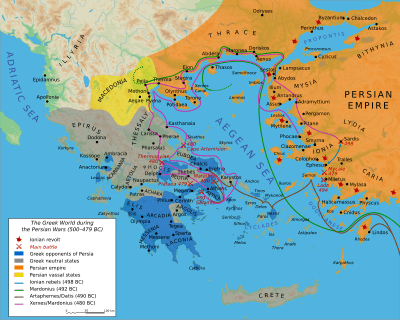Greco–Persian wars facts for kids
Quick facts for kids The Greco-Persian Wars |
|||||||||
|---|---|---|---|---|---|---|---|---|---|
 Greek hoplite and Persian warrior depicted fighting, on an ancient kylix, 5th century BC |
|||||||||
|
|||||||||
| Belligerents | |||||||||
| Greek city states including Athens and Sparta | Achaemenid Empire of Persia Macedon (initial phase) |
||||||||
| Commanders and leaders | |||||||||
| Miltiades Themistocles Leonidas I † Pausanias Cimon † Pericles |
Artaphernes Datis Artaphernes (son of Artaphernes) Xerxes I Mardonius † Hydarnes Artabazus Megabyzus |
||||||||

The Greco–Persian Wars were a long series of battles between the Greek city-states and the Persian Empire. These wars happened in the 5th century BC and lasted for about 50 years, from 499 BC to 449 BC. Much of what we know about these wars comes from a famous Greek historian named Herodotus.
Before these wars began, the powerful Persian Empire, led by Cyrus the Great, had taken control of Greek cities on the western coast of Asia Minor. This area was known to the Greeks as Ionia. The Persians put their own rulers, called tyrants, in charge of each Greek city, or polis.
One of these tyrants, Aristagoras of Miletus, tried to conquer the island of Naxos with Persian help, but he failed. After this, Aristagoras encouraged the Ionian Greeks to rebel against Persian rule. This started the Ionian Revolt. The Greek cities of Athens and Eretria supported the rebels. Together, they attacked and burned Sardis, which was an important Persian city in the region. The Persian king at the time, Darius the Great, was very angry and promised to get even with the Greeks.
The Famous Battle of Marathon
After the Ionian Revolt ended, the Persians decided to invade Greece. One of the most important battles happened on the plain of Marathon. The Greeks won the Battle of Marathon thanks to a clever plan by their general, Miltiades.
Miltiades' strategy was smart. He made the middle part of his army weaker but kept many soldiers on the sides. When the Persians attacked, they rushed towards the weaker middle. But then, the strong Greek forces on the sides moved in, surrounding the Persian army. This surprise move helped the Greeks win a great victory.
Key Events of the Wars
The Greco-Persian Wars involved many important events and battles. Here is a list of the main parts of the conflict:
- Ionian Revolt: 499–493 BC. This was when the Greek cities in Asia Minor rebelled against Persia.
- First invasion of Greece: 492–490 BC. This included the famous Battle of Marathon in 490 BC.
- Second invasion of Greece: 480–479 BC. This was a much larger invasion by the Persians.
- Battle of Thermopylae: 480 BC. A small group of Spartans bravely fought a huge Persian army.
- Battle of Artemisium: 480 BC. A naval battle that happened at the same time as Thermopylae.
- Battle of Salamis: 480 BC. A major naval victory for the Greeks.
- Greek counter-attack: 479–478 BC. The Greeks pushed back against the Persians.
- Battle of Plataea: 479 BC. A decisive land battle where the Greeks defeated the Persian army.
- Wars of the Delian League: 477–449 BC. These were ongoing conflicts where Greek city-states, led by Athens, continued to fight Persia.
What Happened After the Wars?
Even though the main Greco-Persian Wars ended around 449 BC, the Greeks and Persians continued to have conflicts for over a hundred years.
Later, the Greek city-states of Athens and Sparta fought against each other in a series of wars called the Peloponnesian War. During these wars, Persia sometimes helped Sparta, which allowed them to regain some of the land they had lost to the Greeks.
Eventually, a new leader emerged: Alexander the Great from Macedon. In 330 BC, Alexander invaded Asia and completely defeated the Persian king, Darius III. This brought an end to the powerful Achaemenid Empire of Persia.

